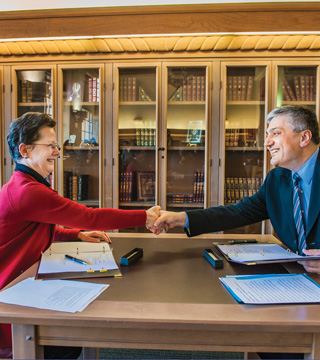
Julia Phillips, Sandia Acting Div. 7000 VP and chief technology officer, and UNM Provost Chaouki Abdallah shake hands after signing the Inter-Institutional Visitors Agreement allowing closer research collaboration. (Photo by Randy Montoya)
Sandia has launched a new kind of collaboration designed to strengthen research bonds between the Labs and the University of New Mexico.
“This is another sign of the close and deepening partnership between two of the pre-eminent research institutions in the state,” Acting Div. 7000 VP and Chief Technology Officer Julia Phillips said at the Jan. 17 signing of the Inter-Institutional Visitor Agreement (IVA). “It enables Sandia to provide access to unique capabilities we have to further the research agenda of UNM. And Sandia has the opportunity to engage with the fine researchers at the university — professors and students. I am delighted.”
Julia signed the agreement with UNM Provost Chaouki Abdallah, who said it will further the missions of the university and Sandia through strategic partnership. “We will leverage our respective strengths and maximize our respective resources,” he said. “New Mexico and the nation will be well served by UNM and Sandia sharing facilities, equipment, and talent. UNM appreciates the significance of this pact and Sandia’s support of our faculty and students.”
An IVA allows Sandia to work collaboratively with academic and research institutions without having to put in place a Cooperative Research & Development Agreement (CRADA), which typically requires a private industrial partner to commercialize the work, says Vic Weiss (10679), who helped negotiate the agreement. “Sometimes we just want to do research with a university, to push the frontiers of science and make discoveries,” he says. “An IVA is an instrument that lets that happen.”
The IVA signed in January will allow UNM staff to irradiate material samples at the Annular Core Research Reactor and the Gamma Irradiation Facility in Tech Area 5. The university researchers want to predict sample response to experimental conditions like those at the Large Hadron Collider in Geneva, Switzerland, which is being upgraded.
Matt Burger, senior manager in Nuclear Facilities and Applied Technology Dept. 1380, says UNM and Sandia will benefit from the collaborative research. “We have a large contingent of staff in Division 1000 looking at radiation effects on materials and electronics,” says Matt, who worked on the agreement with Paul Raglin (1210). “We will share data back and forth. I’m very excited about this collaboration.”
Vic says a condition of an IVA is that the research should closely align with Sandia’s mission. “We have to be trying to solve some engineering or scientific research issue that aligns with our mission and the university’s,” he says. “We want to be able to work with academic and research institutions to leverage our knowledge and expertise in trying to solve some of these more challenging scientific and engineering issues.”
Matt says the agreement will give UNM students access to facilities with capabilities beyond what is available on campus. “It provides a platform for collaborative investigation into radiation effects sciences, which is important to the organization I work for,” he says.
UNM Vice President for Research Mike Dougher said the agreement is a “big step forward because, bottom line, it is the scientist-to-scientist collaborations that are critical to our long-term collaborative success.”
“Previously when UNM and Sandia researchers wanted to collaborate, UNM had to use a project-specific contract to have Sandia staff run the experiments,” he said at the signing. “With this agreement, Sandia technical staff can collaborate directly with UNM researchers and run the experiments together.”
Julia said the IVA will be a model for potential further collaboration between Sandia and UNM. “This could be the first of many with UNM and other institutions,” she said. “It opens the door for academic research institutions to work with Sandia and push the frontiers of science.”